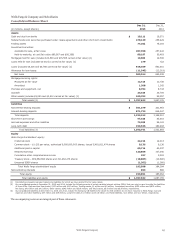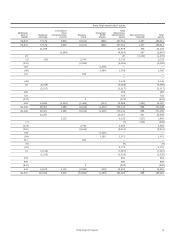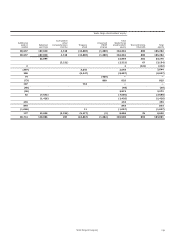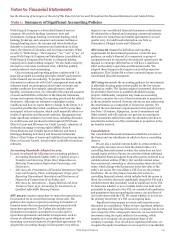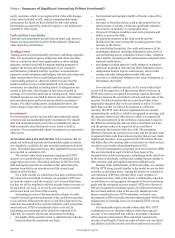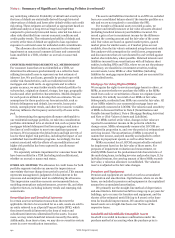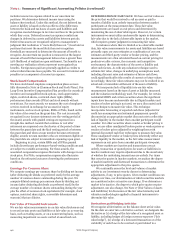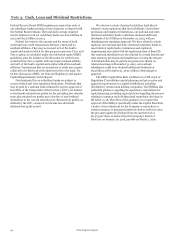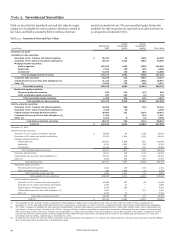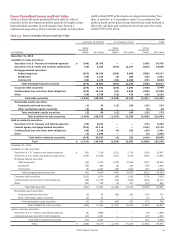Wells Fargo 2015 Annual Report Download - page 147
Download and view the complete annual report
Please find page 147 of the 2015 Wells Fargo annual report below. You can navigate through the pages in the report by either clicking on the pages listed below, or by using the keyword search tool below to find specific information within the annual report.loans in trial payment periods (trial modifications), are
considered impaired loans. Other than resolutions such as
foreclosures, sales and transfers to held-for-sale, we may remove
loans held for investment from TDR classification, but only if
they have been refinanced or restructured at market terms and
qualify as a new loan.
PURCHASED CREDIT-IMPAIRED LOANS Loans acquired with
evidence of credit deterioration since their origination and where
it is probable that we will not collect all contractually required
principal and interest payments are PCI loans. PCI loans are
recorded at fair value at the date of acquisition, and the
historical allowance for credit losses related to these loans is not
carried over. Some loans that otherwise meet the definition as
credit-impaired are specifically excluded from the PCI loan
portfolios, such as revolving loans where the borrower still has
revolving privileges.
Evidence of credit quality deterioration as of the purchase
date may include statistics such as past due and nonaccrual
status, commercial risk ratings, recent borrower credit scores
and recent loan-to-value percentages. Generally, acquired loans
that meet our definition for nonaccrual status are considered to
be credit-impaired.
PCI loans may be aggregated into pools based on common
risk characteristics. Each pool is accounted for as a single asset
with a single composite interest rate and an aggregate
expectation of cash flows. Generally, commercial PCI loans are
accounted for as individual loans and consumer PCI loans are
included in pools.
Accounting for PCI loans involves estimating fair value at
acquisition using the principal and interest cash flows expected
to be collected discounted at the prevailing market rate of
interest. The excess of cash flows expected to be collected over
the carrying value (estimated fair value at acquisition date) is
referred to as the accretable yield and is recognized in interest
income using an effective yield method over the remaining life of
the loan, or pool of loans, in situations where there is a
reasonable expectation about the timing and amount of cash
flows to be collected. The difference between contractually
required payments and the cash flows expected to be collected at
acquisition, considering the impact of prepayments, is referred
to as the nonaccretable difference.
Subsequent to acquisition, we regularly evaluate our
estimates of cash flows expected to be collected. If we have
probable decreases in cash flows expected to be collected (other
than due to decreases in interest rate indices and changes in
prepayment assumptions), we charge the provision for credit
losses, resulting in an increase to the allowance for loan losses. If
we have probable and significant increases in cash flows
expected to be collected, we first reverse any previously
established allowance for loan losses and then increase interest
income as a prospective yield adjustment over the remaining life
of the loan, or pool of loans. Estimates of cash flows are
impacted by changes in interest rate indices for variable rate
loans and prepayment assumptions, both of which are treated as
prospective yield adjustments included in interest income.
Resolutions of loans may include sales of loans to third
parties, receipt of payments in settlement with the borrower, or
foreclosure of the collateral. For individual PCI loans, gains or
losses on sales to third parties are included in noninterest
income, and gains or losses as a result of a settlement with the
borrower are included in interest income. Our policy is to
remove an individual loan from a pool based on comparing the
amount received from its resolution with its contractual amount.
Any difference between these amounts is absorbed by the
nonaccretable difference for the entire pool. This removal
method assumes that the amount received from resolution
approximates pool performance expectations. The remaining
accretable yield balance is unaffected and any material change in
remaining effective yield caused by this removal method is
addressed by our quarterly cash flow evaluation process for each
pool. For loans that are resolved by payment in full, there is no
release of the nonaccretable difference for the pool because there
is no difference between the amount received at resolution and
the contractual amount of the loan. Modified PCI loans are not
removed from a pool even if those loans would otherwise be
deemed TDRs. Modified PCI loans that are accounted for
individually are considered TDRs and removed from PCI
accounting if there has been a concession granted in excess of
the original nonaccretable difference. We include these TDRs in
our impaired loans.
FORECLOSED ASSETS Foreclosed assets obtained through our
lending activities primarily include real estate. Generally, loans
have been written down to their net realizable value prior to
foreclosure. Any further reduction to their net realizable value is
recorded with a charge to the allowance for credit losses at
foreclosure. We allow up to 90 days after foreclosure to finalize
determination of net realizable value. Thereafter, changes in net
realizable value are recorded to noninterest expense. The net
realizable value of these assets is reviewed and updated
periodically depending on the type of property. Certain
government-guaranteed mortgage loans upon foreclosure are
included in accounts receivable, not foreclosed assets. These
receivables were loans predominantly insured by the FHA or
guaranteed by the VA and are measured based on the balance
expected to be recovered from the guarantor.
ALLOWANCE FOR CREDIT LOSSES (ACL) The allowance for
credit losses is management’s estimate of credit losses inherent
in the loan portfolio, including unfunded credit commitments, at
the balance sheet date. We have an established process to
determine the appropriateness of the allowance for credit losses
that assesses the losses inherent in our portfolio and related
unfunded credit commitments. We develop and document our
allowance methodology at the portfolio segment level –
commercial loan portfolio and consumer loan portfolio. While
we attribute portions of the allowance to our respective
commercial and consumer portfolio segments, the entire
allowance is available to absorb credit losses inherent in the total
loan portfolio and unfunded credit commitments.
Our process involves procedures to appropriately consider
the unique risk characteristics of our commercial and consumer
loan portfolio segments. For each portfolio segment, losses are
estimated collectively for groups of loans with similar
characteristics, individually or pooled for impaired loans or, for
PCI loans, based on the changes in cash flows expected to be
collected.
Our allowance levels are influenced by loan volumes, loan
grade migration or delinquency status, historic loss experience
and other conditions influencing loss expectations, such as
economic conditions.
COMMERCIAL PORTFOLIO SEGMENT ACL METHODOLOGY
Generally, commercial loans are assessed for estimated losses by
grading each loan using various risk factors as identified through
periodic reviews. Our estimation approach for the commercial
portfolio reflects the estimated probability of default in
accordance with the borrower’s financial strength and the
severity of loss in the event of default, considering the quality of
Wells Fargo & Company
145


